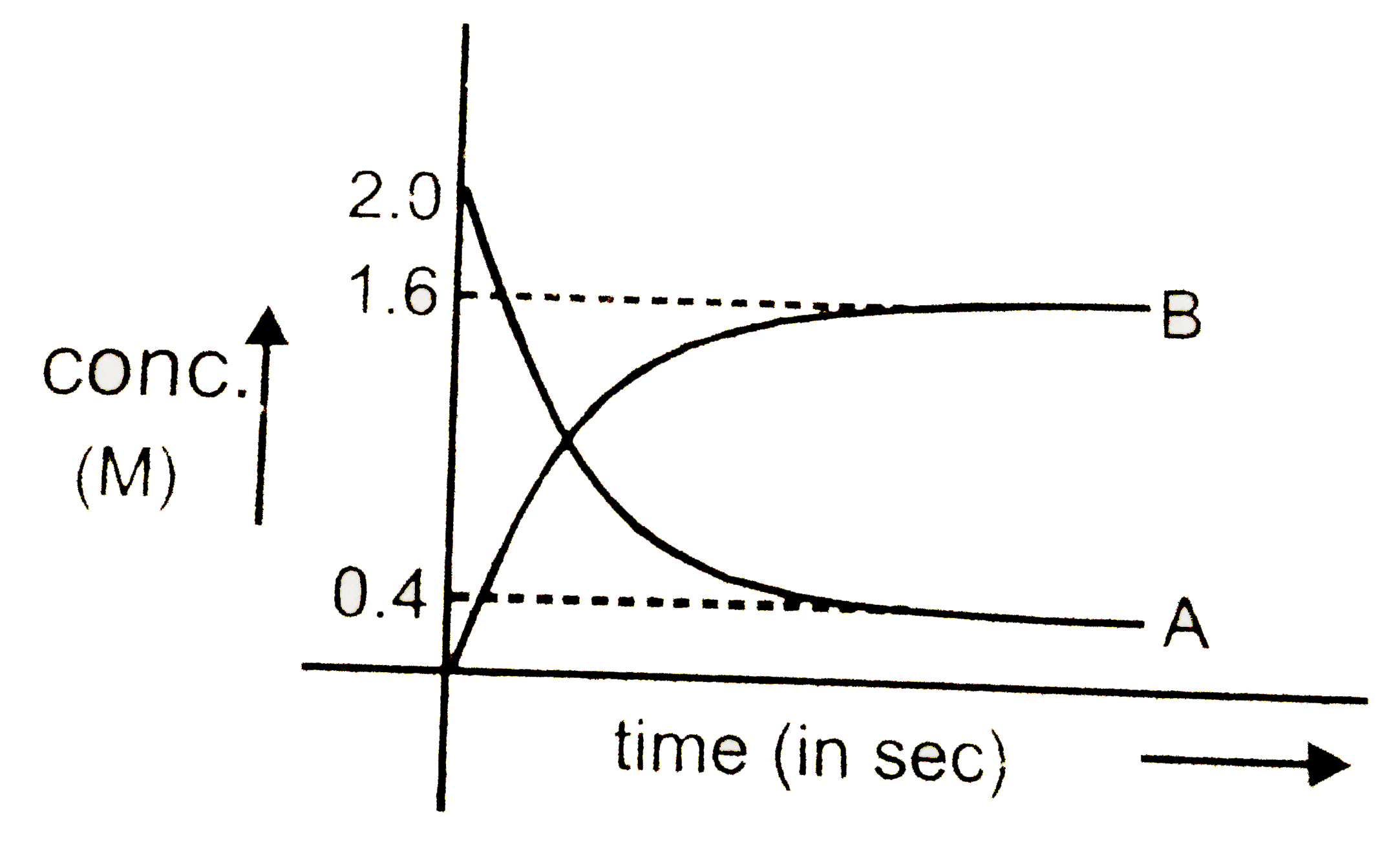For the reaction AK1sec−1⇐==⇒k2sec−1B following graph is given,
k1=4×10−2sec−1. Which is/are correct statement (s) (In 2=0.7 , In 8/7 =0.14)
 Solution in Telugu
Solution in Telugu
equilibrium constant is 4.0
Time taken for the completion fo 50% fo equilibrium conc. Of B is 14 sec.
Time taken for the completion of 10% of initial conc. Of A is 2.8 sec.
Rate constant of backward reaction is 10−2sec−1
The correct Answer is:A, B, C, D
Step by step video & image solution for For the reaction Aunderset(k_(2)"sec"^(-1))overset(K_(1)"sec"^(-1))hArr B following graph is given, k_(1) =4 xx 10^(-2)"sec"^(-1). Which is/are correct statement (s) (In 2=0.7 , In 8/7 =0.14) by Chemistry experts to help you in doubts & scoring excellent marks in Class 12 exams.
Updated on:21/07/2023Topper's Solved these Questions
- CHEMICAL KINETIC & NUCLEAR CHEMISTRYBOOK - NARENDRA AWASTHICHAPTER - CHEMICAL KINETIC & NUCLEAR CHEMISTRYEXERCISE - Level 3 - Assertion - Reason Type Questions
3 Videos
- CHEMICAL KINETIC & NUCLEAR CHEMISTRYBOOK - NARENDRA AWASTHICHAPTER - CHEMICAL KINETIC & NUCLEAR CHEMISTRYEXERCISE - Level 3 - Subjective Problems
3 Videos
- CHEMICAL KINETIC & NUCLEAR CHEMISTRYBOOK - NARENDRA AWASTHICHAPTER - CHEMICAL KINETIC & NUCLEAR CHEMISTRYEXERCISE - Level 3 - Passage
1 Video
- SURFACE CHEMISTRYBOOK - NARENDRA AWASTHICHAPTER - SURFACE CHEMISTRYEXERCISE - Level 3 - Assertion - Reason Type Questions
1 Video
Similar Questions
Each question contains STATEMENTS-1 (Assertion) and STATEMENT -2 (Reason).
Examine the statements carefully and mark the correct answer according to the instructions given below:
STATEMENTS-1: Acid catalysed hydrolysis of esters is pseudo first order reaction.
STATEMETNT-2:Water is present in excess in given reaction.
View Solution5A→Product
In above reaction, half-life period is directly proportional to initial concentration of reactant. The initial rate of reaction is 400 mol lit−1 min−1. Calculate the half - life period ( in sec ) when initial concentration of reactant is 200 mol lit−1 min−1.
View SolutionTwo consecutive irreversible fierst order reactions can be represented by
Ak1−−→Bk2−−→C
The rate equation for A is readily interated to obtain
[A]t=[A]0.e−k1t , and [B]t=k1[A]0k2−k1[e−kt1−e−kt2]
If k1 and k2 both are almost same then which graph is most suitable ?
View Solutioneach question constain STATEMENT-1(Assertion ) and STATEMENT - 2 (reason). examine the statement carefully and work the correct answer accoridng to the instructions given below :
STATEMENT-1: Dispersed phase particles of colloidal solution cannot pass through ultra -filter paper.
STATEMENT-2: The size of colloidal particles are larger than the size of true solution particles.
View SolutionEquilibrium constants for four different reaction are given as K1=106,K2=10−4,K3=10, and K4=1. Which reaction will take maximum time to attain equilibrium?
View SolutionN_(2)O_(2) hArr 2NO, K_(1), (1/2)N_(2)+(1/2)O_(2) hArr NO, K_(2), 2NO hArr N_(2)+O_(2),K_(3), NO hArr (1/2)N_(2)+(1/2)O_(2),K_(4) Correct relaton(s) between K_(1), K_(2), K_(3) and K_(4) is/are
View SolutionFor and elementary reaction 2A underset(k_(2))overset(k_(1))hArr B , the rate of disappearance of A iss equal to (a) (2k_(1))/(k_(2))[A]^(2) (b) -2k_(1)[A]^(2) + 2k_(2)[B] ( c) 2k_(1)[A]^(2) - 2k_(2)[B] (d) (2k_(1) - k_(2))[A]
View SolutionConisder the following reactions:
I. A+Bk1⇐⇒k−1C
II. C+Bk2−−→D
Then k1[A][B]−k−1[C]−k2[C][B] is equal to
View SolutionFor the following sequential reaction,
AK1−−→BK2−−→C
Find out the concentraion of C at tiem t=1 day. Given that K1=1.8×10−5s−1 and K2=1.1×10−2s−1 and initial molar concentration of A is 1.8
View SolutionFor a reversible first-order reaction, A underset(K_(2))overset(K_(1))(hArr)B, K_(f)=10^(-2) s^(-1) and B_(eq.)/A_(eq.)=4, If A_(0)=0.01 ML^(-1) and B_(0)=0 , what will be concentration of B after 30 sec ?
View SolutionFor the reaction AK1sec−1⇐==⇒k2sec−1B following graph is given,
k1=4×10−∘sec−1. Which is/are correct statement (s) (In 2=0.7 , In 8/7 =0.14)

View SolutionFor an elementary chemical reaction, A_(2) underset(k_(-1))overset(k_(1))(hArr) 2A , the expression for (d[A])/(dt) is
View SolutionA substance undergoes a series of chemical reaction as shown
Ak1−−→Bk2−−→Ck3−−→D with rate constant
k1=In22000sec−1,k2=In210sec−1,k3=20In2sec−1 What will be the value of [A][C] once steady stateis obtained?
{[ ] represents concentration}
View SolutionFor a reversible reaction A underset(k_(2)=2 xx 10^(2)s^(-1))overset(k_(1)=4xx10^(2)s^(-1))hArr B initial concentration of A is 21 mol L^(-1) . Select the correct statement:
View SolutionThe substance undergoes first order decomposition. The decomposition follows two parallel first order reactions as : K_(1)=1.26xx10^(-4) sec^(-1) and K_(2) =3.8xx10^(-5) sec^(-1) The percentage distribution of B and C
View SolutionFor 2A overset(k_(1)) rarr B overset(k_(2)) rarr3C. K_(1) =2xx10^(-4) sec^(-1) and k_(2) =3xx10^(-4) /mol-sec. {d[B]/dt} equal to :
View Solution